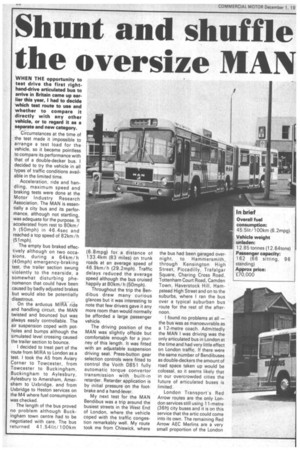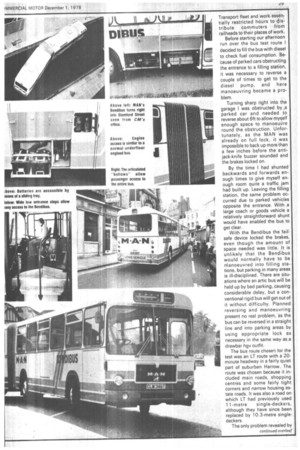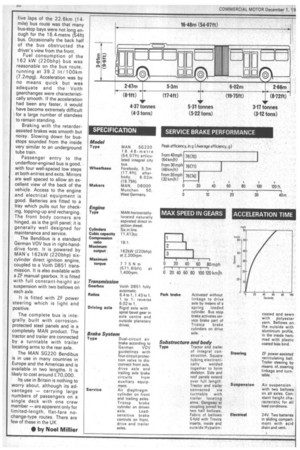Shunt and shuffle the oversize MAN
Page 30

Page 31

Page 32

If you've noticed an error in this article please click here to report it so we can fix it.
WHEN THE opportunity to test drive the first righthand-drive articulated bus to arrive in Britain came up earlier this year. I had to decide which test route to use and whether to compare it directly with any other vehicle, or to regard it as a separate and new category.
Circumstances at the time of the test made it impossible to arrange a test load for the vehicle, so it became pointless to compare its performance with that of a double-decker bus. I decided to try the vehicle in all types of traffic conditions available in the limited time.
Acceleration, ride and handling, maximum speed and braking tests were done at the Motor Industry Research Association. The MAN is essentially a city bus and its performance, although not startling, was adequate for the purpose. It accelerated from rest to 80km/ h (50mph) in 46.4sec and reached a top speed of 82km /h (51mph).
The empty bus braked effectively although on two occasions, during a 64km/ h (40mph) emergency-braking test, the trailer section swung violently to the nearside, a somewhat disturbing phenomenon that could have been caused by badly adjusted brakes but would also be potentially disastrous.
On the arduous MIRA ride and handling circuit, the MAN twisted and bounced but was always easily controllable. The air suspension coped with potholes and bumps although the simulated level crossing caused the trailer section to bounce.
I decided to treat part of the route from MIRA to London as a test. I took the A5 from Aviary Corner to Towcester, from Towcester to Buckingham, Buckingham to Aylesbury, Aylesbury to Amersham, Amersham to Uxbridge, and from Uxbridge to Heston services on the M4 where fuel consumption was checked.
The length of the bus proved no problem although Buckingham town centre had to be negotiated with care. The bus returned 41.54111/ 100km (6.8mpg) for a distance ot 133.4km (83 miles) on trunk roads at an average speed of 46.9km/ h (29.2mph). Traffic delays reduced the average speed although the bus cruised happily at 80km/ h (50mph).
Throughout the trip the Bendibus drew many curious glances but it was interesting to note that few drivers gave it any more room than would normally be afforded a large passenger vehicle.
The driving position of the MAN was slightly offside but comfortable enough for a journey of this length. It was fitted with an adjustable suspension driving seat. Press-button gear selection controls were fitted to control the Voith D851 fully automatic torque convertor transmission with built-in retarder. Retarder application is by initial pressure on the footbrake and a hand-lever.
My next test for the MAN Bendibus was a trip around the busiest streets in the West End of London, where the vehicle coped with the traffic congestion remarkably well. My route took me from Chiswick, where the bus had been garaged overnight, to Hammersmith, through Kensington High Street, Piccadilly, Trafalgar Square, Charing Cross Road, Tottenham Court Road, Camden Town, Haverstock Hill, Hampstead High Street and on to the suburbs, where I ran the bus over a typical suburban bus route for the rest of the afternoon.
I found no problems at all — the bus was as manoeuvrable as a 12-metre coach. Admittedly the MAN I was driving was the only articulated bus in London at the time and had very little effect on London traffic. If there were the same number of Bendibuses as double-deckers the amount of road space taken up would be colossal, so it seems likely that in our overcrowded cities the future of articulated buses is limited.
London Transport's Red Arrow routes are the only London services still using 11-metre (36ft) city buses and it is on this service that the artic could come into its own. The remaining Red Arrow AEC Merlins are a very small proportion of the London Transport fleet and work essentially restricted hours to distribute commuters from railheads to their places of work.
Before starting our afternoon run over the bus test route I decided to fill the bus with diesel to check fuel consumption. BeCause of parked cars obstructing the entrance to a filling station, it was necessary to reverse a couple of times to get to the diesel pump, and here manoeuvring became a problem.
Turning sharp right into the garage I was obstructed by a parked car and needed to reverse about eft to allow myself enough space to manoeuvre round the obstruction. Unfortunately, as the MAN was already on full lock, it was impossible to back up more than a few inches before the antijack-knife buzzer sounded and the brakes locked on.
By the time I had shunted backwards and forwards enough times to give myself enough room quite a traffic jam had built up. Leaving the filling station, the same problem occurred due to parked vehicles opposite the entrance. With a large coach or goods vehicle a relatively straightforward shunt would have enabled the bus to get clear.
With the Bendibus the failsafe device locked the brakes, even though the amount of space needed was little. It is unlikely that the Bendibus would normally have to be nianoeuvred into filling stations, but parking in many areas is ill-disciplined. There are situations where an artic bus will be held up by bad parking, causing considerable delay, but a conventional rigid bus will get out of it without difficulty. Planned reversing and manoeuvring present no real problem, as the bus can be reversed in a straight line and into parking areas by using appropriate lock as necessary in the same way.as a drawbar hgv outfit.
The bus route chosen i for the test was an LT route with a 20minute headway in a fairly quiet part of suburban Harrow. The route was chosen because it included main roads, shopping centres and some fairly tight corners and narrow housing estate roads. It was also a road on which LT had previously used 11-metre single-deckers, although they have since been replaced by 10.3-metre singledeckers.
The only problem revealed by five laps of the 22.6km (14mile) bus route was that many bus-stop bays were not long .enough for the 16.4-metre (54ft) bus. Occasionally the back half of the bus obstructed the driver's view from the front.
Fuel consumption of the 162 kW (220bhp) bus was reasonable on the bus route,.
running at 39.2 lit/100km (7.2mpg). Acceleration was by no means quick but was adequate and the Voith gearchanges were characteristi cally smooth. If the acceleration had been any faster, it would have become extremely difficult for a large number of standees to remain standing.
Braking with the retarderassisted brakes was smooth but noisy. Slowing down for busstops sounded from the inside very similar to an underground tube train.
Passenger entry to the underfloor-engined bus is good, with four well-spaced low steps at both entries and exits. Mirrors are well spaced to allow an ex cellent view of the back of the vehicle. Access to the engine and electrical equipment is good. Batteries are fitted to a tray which pulls out for checking, topping-up and recharging.
The front body corners are hinged, as is the grill panel; it is generally well designed for maintenance and service.
The Bendibus is a standard German VOV bus in right-hand drive form. It is powered by MAN's 162kW (220bhp) sixcylinder direct ignition engine, coupled to a Voith D851 trans mission. It is also available with a ZF manual gearbox. It is fitted with full constant-height air suspension with two bellows on each axle.
It is fitted with ZF power steering which is light and positive.
The complete bus is integrally built with corrosion protected steel panels and is a completely MAN product. The tractor and trailer are connected by a turntable with trailer locating arms to the rear axle.
The MAN SG2 20 Bendibus is in use in many countries in Europe and the Americas and is available in two lengths. It is likely to cost around £70,000.
Its use in Britain is nothing to worry about, although its ad
vantages — carrying large numbers of passengers on a single deck with one crew member — are apparent only for limited-length, flat-fare nochange-type routes. There are few of these in the UK.


































































































































